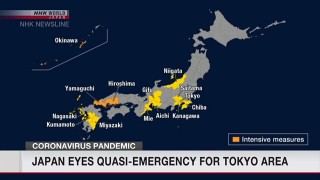Loading
Search
▼ Japan Eyes Quasi-Emergency For Tokyo Area
- Category:Other
The Japanese government is considering imposing stricter anti-virus measures in Tokyo and three surrounding prefectures to curb the rapid spread of the Omicron coronavirus variant.
On Monday, Japanese health officials confirmed more than 20,000 new cases of the coronavirus nationwide for the fourth consecutive day.
In Tokyo, the occupancy rate of hospital beds was 21.1 percent on Monday, surpassing the 20-percent mark that the Tokyo Metropolitan Government views as a threshold for asking the central government to impose stricter measures.
Tokyo and three surrounding prefectures -- Saitama, Chiba and Kanagawa -- on Monday jointly requested the quasi-emergency measures.
In central Japan's Tokai region, Gifu and Mie prefectures have already requested the measures. Neighboring Aichi Prefecture is expected to follow suit on Tuesday.
The Japanese government is preparing to declare a quasi-emergency for those prefectures as well as Niigata, Nagasaki, Kumamoto and Miyazaki prefectures, where infections are rising.
The government is considering imposing restrictions in those prefectures for about three weeks.
The government is also contemplating suspending the use of coronavirus vaccine records and proof of negative test results to relax social restrictions.
Reports that even fully vaccinated people have been infected with the Omicron variant have called into question the effectiveness of the so-called vaccine and PCR testing package.
Prime Minister Kishida Fumio will meet with relevant ministers, including the health minister and the minister in charge of coronavirus measures, on Tuesday to discuss the government response.
The government's task force is expected to make a decision as early as Wednesday after consulting with a panel of infectious disease experts.
The prefectures of Okinawa, Yamaguchi and Hiroshima have been under a state of quasi-emergency since January 9.
On Monday, Japanese health officials confirmed more than 20,000 new cases of the coronavirus nationwide for the fourth consecutive day.
In Tokyo, the occupancy rate of hospital beds was 21.1 percent on Monday, surpassing the 20-percent mark that the Tokyo Metropolitan Government views as a threshold for asking the central government to impose stricter measures.
Tokyo and three surrounding prefectures -- Saitama, Chiba and Kanagawa -- on Monday jointly requested the quasi-emergency measures.
In central Japan's Tokai region, Gifu and Mie prefectures have already requested the measures. Neighboring Aichi Prefecture is expected to follow suit on Tuesday.
The Japanese government is preparing to declare a quasi-emergency for those prefectures as well as Niigata, Nagasaki, Kumamoto and Miyazaki prefectures, where infections are rising.
The government is considering imposing restrictions in those prefectures for about three weeks.
The government is also contemplating suspending the use of coronavirus vaccine records and proof of negative test results to relax social restrictions.
Reports that even fully vaccinated people have been infected with the Omicron variant have called into question the effectiveness of the so-called vaccine and PCR testing package.
Prime Minister Kishida Fumio will meet with relevant ministers, including the health minister and the minister in charge of coronavirus measures, on Tuesday to discuss the government response.
The government's task force is expected to make a decision as early as Wednesday after consulting with a panel of infectious disease experts.
The prefectures of Okinawa, Yamaguchi and Hiroshima have been under a state of quasi-emergency since January 9.
- January 18, 2022
- Comment (0)
- Trackback(0)


